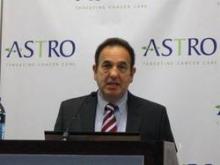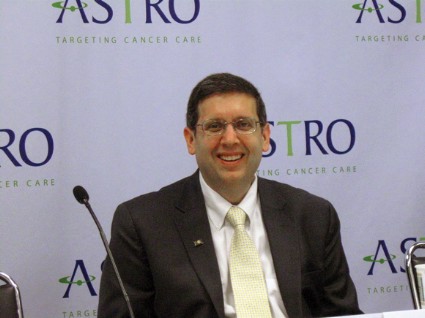User login
ATLANTA – In patients undergoing radiation therapy for locally advanced non–small cell lung cancer, quality-of-life scores were more predictive of overall survival than were tumor stage or performance status, Dr. Benjamin Movsas reported at the annual meeting of the American Society for Radiation Oncology.
Among patients in the RTOG 0617 trial, every baseline increase of 10 points on a validated lung cancer quality-of-life scale was associated with a 14% reduction in the risk of death. In multivariate analysis, neither performance status nor tumor stage significantly predicted overall survival, whereas quality-of-life scores did, said Dr. Movsas, chairman of radiation oncology at the Henry Ford Health System in Detroit.
Results of the RTOG 0617 trial, reported at the 2011 ASTRO annual meeting, indicated that higher radiation doses did not improve overall survival. At 1 year, median overall survival was 81% for patients randomized to treatment with standard-dose (60-Gy) radiation and 70.4% for those who received high-dose (74-Gy) radiation. The respective median survival rates were 21.7 months and 20.7 months (P = .02).
The high-dose arm of the study was stopped in June 2011 when a planned interim analysis showed that the radiation comparison had crossed the prespecified boundary for futility.
"Why was the survival actually lower in patients who received the higher dose of radiation? When we look at the toxicity, as scored by the physicians, there were few if any differences," Dr. Movsas noted in a press briefing prior to his presentation of the data in a plenary session.
To answer that question, researchers looked at patient-reported quality-of-life data from RTOG 0617, which was collected at baseline, 3 months from the start of treatment, and again at 12 months using the FACT-TOI (Functional Assessment of Cancer Therapy–Trial Outcome Index). The index comprises items touching on physical and functional well-being, as well as a lung cancer subscale. Clinically meaningful changes are a point change of 2 or more on each of the subscales, and a point change of 5 or more on the overall scale.
Patients who received the higher radiation dose had clinically meaningful declines in quality-of-life scores on the lung cancer subscale at 3 months compared with baseline. The decrease was 46% among patients in the high-dose arm and 31% in the standard-dose arm (P = .024). At 12 months, however, the changes over baseline were not significantly different at 39% and 36%, respectively.
"Beyond the radiation level, the baseline quality of life also predicted for survival, as well as in multivariate analysis," Dr. Movsas said.
Although the study was not randomized by treatment type, intensity-modulated radiation therapy (IMRT) was used in 41% of patients who received the 60-Gy dose and who completed quality-of-life evaluations, and in 44% of patients who received 74 Gy and completed the evaluations. The remaining patients in each group received 3D conformal radiation therapy.
Significantly more patients with stage IIIB disease and larger gross tumor volumes were treated with IMRT. Nonetheless, there was a trend at 3 months toward a smaller decline in quality of life at 3 months (43% for 3D vs. 31% for IMRT; P = .06) and a significant difference at 12 months (47% vs. 23%; P = .005).
"Despite few differences in provider-reported toxicity between the arms, the patient-reported outcomes help tell us at least part of the rest of the story by showing significantly worse quality of life on the high-dose arm at 3 months, confirming the quality-of-life hypothesis," Dr. Movsas said.
The finding "raises the intriguing question of whether the decline in quality of life on the high-dose arm may help account for the survival decrement in this arm over time," he added.
The researchers are also looking at other factors that might account for the survival difference, including the volume of the heart irradiated and local failure rates.
A radiation oncologist who was not involved in the study said that it emphasizes the importance of collecting and analyzing patient-outcomes data.
Although the study’s primary endpoint showed that dose escalation did not improve outcomes, "we find out as a secondary analysis that patients who received intensity-modulated radiation therapy, which spares normal tissues, had a better quality of life," said Dr. Bruce G. Haffty, a radiation oncologist at the Cancer Institute of New Jersey in New Brunswick, and ASTRO president-elect.
Dr. Haffty moderated the briefing in which Dr. Movsas discussed his data.
RTOG 0617 was supported by the National Cancer Institute. Dr. Movsas disclosed departmental research support from Varian and Philips. Dr. Haffty reported having no relevant disclosures.
ATLANTA – In patients undergoing radiation therapy for locally advanced non–small cell lung cancer, quality-of-life scores were more predictive of overall survival than were tumor stage or performance status, Dr. Benjamin Movsas reported at the annual meeting of the American Society for Radiation Oncology.
Among patients in the RTOG 0617 trial, every baseline increase of 10 points on a validated lung cancer quality-of-life scale was associated with a 14% reduction in the risk of death. In multivariate analysis, neither performance status nor tumor stage significantly predicted overall survival, whereas quality-of-life scores did, said Dr. Movsas, chairman of radiation oncology at the Henry Ford Health System in Detroit.
Results of the RTOG 0617 trial, reported at the 2011 ASTRO annual meeting, indicated that higher radiation doses did not improve overall survival. At 1 year, median overall survival was 81% for patients randomized to treatment with standard-dose (60-Gy) radiation and 70.4% for those who received high-dose (74-Gy) radiation. The respective median survival rates were 21.7 months and 20.7 months (P = .02).
The high-dose arm of the study was stopped in June 2011 when a planned interim analysis showed that the radiation comparison had crossed the prespecified boundary for futility.
"Why was the survival actually lower in patients who received the higher dose of radiation? When we look at the toxicity, as scored by the physicians, there were few if any differences," Dr. Movsas noted in a press briefing prior to his presentation of the data in a plenary session.
To answer that question, researchers looked at patient-reported quality-of-life data from RTOG 0617, which was collected at baseline, 3 months from the start of treatment, and again at 12 months using the FACT-TOI (Functional Assessment of Cancer Therapy–Trial Outcome Index). The index comprises items touching on physical and functional well-being, as well as a lung cancer subscale. Clinically meaningful changes are a point change of 2 or more on each of the subscales, and a point change of 5 or more on the overall scale.
Patients who received the higher radiation dose had clinically meaningful declines in quality-of-life scores on the lung cancer subscale at 3 months compared with baseline. The decrease was 46% among patients in the high-dose arm and 31% in the standard-dose arm (P = .024). At 12 months, however, the changes over baseline were not significantly different at 39% and 36%, respectively.
"Beyond the radiation level, the baseline quality of life also predicted for survival, as well as in multivariate analysis," Dr. Movsas said.
Although the study was not randomized by treatment type, intensity-modulated radiation therapy (IMRT) was used in 41% of patients who received the 60-Gy dose and who completed quality-of-life evaluations, and in 44% of patients who received 74 Gy and completed the evaluations. The remaining patients in each group received 3D conformal radiation therapy.
Significantly more patients with stage IIIB disease and larger gross tumor volumes were treated with IMRT. Nonetheless, there was a trend at 3 months toward a smaller decline in quality of life at 3 months (43% for 3D vs. 31% for IMRT; P = .06) and a significant difference at 12 months (47% vs. 23%; P = .005).
"Despite few differences in provider-reported toxicity between the arms, the patient-reported outcomes help tell us at least part of the rest of the story by showing significantly worse quality of life on the high-dose arm at 3 months, confirming the quality-of-life hypothesis," Dr. Movsas said.
The finding "raises the intriguing question of whether the decline in quality of life on the high-dose arm may help account for the survival decrement in this arm over time," he added.
The researchers are also looking at other factors that might account for the survival difference, including the volume of the heart irradiated and local failure rates.
A radiation oncologist who was not involved in the study said that it emphasizes the importance of collecting and analyzing patient-outcomes data.
Although the study’s primary endpoint showed that dose escalation did not improve outcomes, "we find out as a secondary analysis that patients who received intensity-modulated radiation therapy, which spares normal tissues, had a better quality of life," said Dr. Bruce G. Haffty, a radiation oncologist at the Cancer Institute of New Jersey in New Brunswick, and ASTRO president-elect.
Dr. Haffty moderated the briefing in which Dr. Movsas discussed his data.
RTOG 0617 was supported by the National Cancer Institute. Dr. Movsas disclosed departmental research support from Varian and Philips. Dr. Haffty reported having no relevant disclosures.
ATLANTA – In patients undergoing radiation therapy for locally advanced non–small cell lung cancer, quality-of-life scores were more predictive of overall survival than were tumor stage or performance status, Dr. Benjamin Movsas reported at the annual meeting of the American Society for Radiation Oncology.
Among patients in the RTOG 0617 trial, every baseline increase of 10 points on a validated lung cancer quality-of-life scale was associated with a 14% reduction in the risk of death. In multivariate analysis, neither performance status nor tumor stage significantly predicted overall survival, whereas quality-of-life scores did, said Dr. Movsas, chairman of radiation oncology at the Henry Ford Health System in Detroit.
Results of the RTOG 0617 trial, reported at the 2011 ASTRO annual meeting, indicated that higher radiation doses did not improve overall survival. At 1 year, median overall survival was 81% for patients randomized to treatment with standard-dose (60-Gy) radiation and 70.4% for those who received high-dose (74-Gy) radiation. The respective median survival rates were 21.7 months and 20.7 months (P = .02).
The high-dose arm of the study was stopped in June 2011 when a planned interim analysis showed that the radiation comparison had crossed the prespecified boundary for futility.
"Why was the survival actually lower in patients who received the higher dose of radiation? When we look at the toxicity, as scored by the physicians, there were few if any differences," Dr. Movsas noted in a press briefing prior to his presentation of the data in a plenary session.
To answer that question, researchers looked at patient-reported quality-of-life data from RTOG 0617, which was collected at baseline, 3 months from the start of treatment, and again at 12 months using the FACT-TOI (Functional Assessment of Cancer Therapy–Trial Outcome Index). The index comprises items touching on physical and functional well-being, as well as a lung cancer subscale. Clinically meaningful changes are a point change of 2 or more on each of the subscales, and a point change of 5 or more on the overall scale.
Patients who received the higher radiation dose had clinically meaningful declines in quality-of-life scores on the lung cancer subscale at 3 months compared with baseline. The decrease was 46% among patients in the high-dose arm and 31% in the standard-dose arm (P = .024). At 12 months, however, the changes over baseline were not significantly different at 39% and 36%, respectively.
"Beyond the radiation level, the baseline quality of life also predicted for survival, as well as in multivariate analysis," Dr. Movsas said.
Although the study was not randomized by treatment type, intensity-modulated radiation therapy (IMRT) was used in 41% of patients who received the 60-Gy dose and who completed quality-of-life evaluations, and in 44% of patients who received 74 Gy and completed the evaluations. The remaining patients in each group received 3D conformal radiation therapy.
Significantly more patients with stage IIIB disease and larger gross tumor volumes were treated with IMRT. Nonetheless, there was a trend at 3 months toward a smaller decline in quality of life at 3 months (43% for 3D vs. 31% for IMRT; P = .06) and a significant difference at 12 months (47% vs. 23%; P = .005).
"Despite few differences in provider-reported toxicity between the arms, the patient-reported outcomes help tell us at least part of the rest of the story by showing significantly worse quality of life on the high-dose arm at 3 months, confirming the quality-of-life hypothesis," Dr. Movsas said.
The finding "raises the intriguing question of whether the decline in quality of life on the high-dose arm may help account for the survival decrement in this arm over time," he added.
The researchers are also looking at other factors that might account for the survival difference, including the volume of the heart irradiated and local failure rates.
A radiation oncologist who was not involved in the study said that it emphasizes the importance of collecting and analyzing patient-outcomes data.
Although the study’s primary endpoint showed that dose escalation did not improve outcomes, "we find out as a secondary analysis that patients who received intensity-modulated radiation therapy, which spares normal tissues, had a better quality of life," said Dr. Bruce G. Haffty, a radiation oncologist at the Cancer Institute of New Jersey in New Brunswick, and ASTRO president-elect.
Dr. Haffty moderated the briefing in which Dr. Movsas discussed his data.
RTOG 0617 was supported by the National Cancer Institute. Dr. Movsas disclosed departmental research support from Varian and Philips. Dr. Haffty reported having no relevant disclosures.
AT THE ASTRO ANNUAL MEETING
Major finding: Clinically meaningful declines from baseline lung cancer quality-of-life subscale scores at 3 months were 46% in patients treated with 74 Gy and 31% in patients treated with 60 Gy (P = .024).
Data source: Analysis of prospective data on quality of life from the RTOG 0617 trial.
Disclosures: RTOG 0617 was supported by the National Cancer Institute. Dr. Movsas disclosed departmental research support from Varian and Philips. Dr. Haffty reported having no relevant disclosures.


